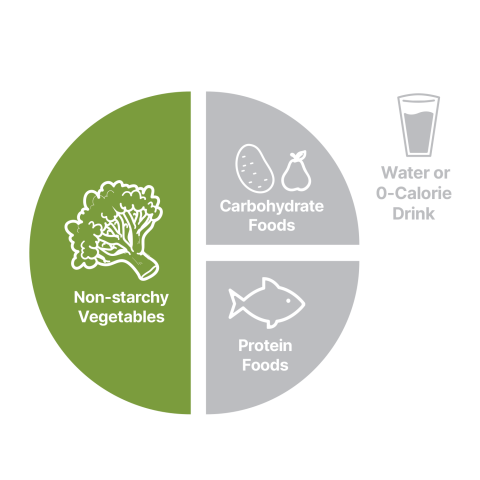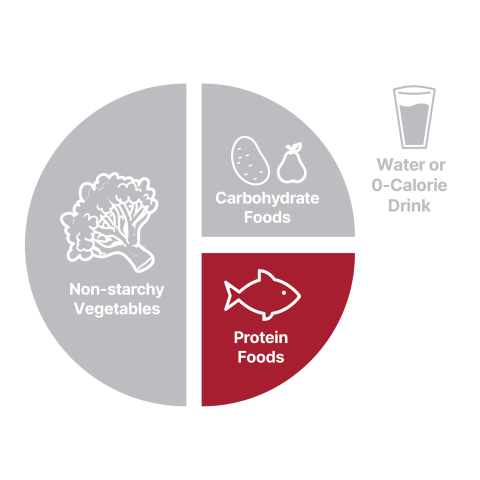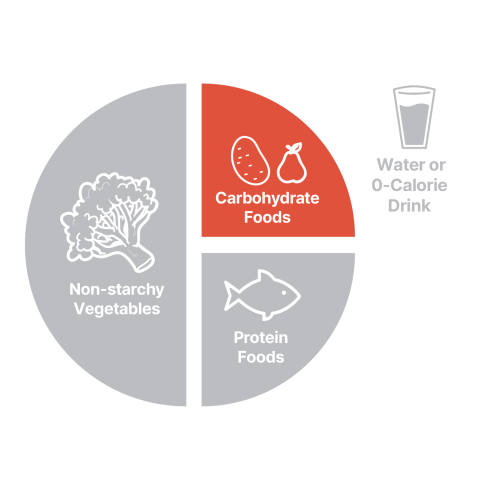You may have seen the word “superfood” used on social media, on food packages, or in advertisements. It is a marketing term used to promote a food thought to have “extra” health benefits. However, there is no official definition of the word by the Food and Drug Administration (FDA). The FDA regulates the health claims allowed on food labels to ensure there is scientific research to support the claims.
However, our list of “superstar” foods for diabetes are essential for a healthy diabetes meal plan. These foods are rich in protein, healthy fats, vitamins, minerals, antioxidants, and fiber. They are good for overall health and may also help prevent diseases like diabetes.
Superstar Non-Starchy Vegetables

According to the Diabetes Plate, non-starchy vegetables should make up half of your meal.
Dark green leafy vegetables
Packed with vitamins and minerals such as vitamins A, C, K, and folate; iron; calcium; and potassium, these foods are low in calories and carbohydrates and fit on the non-starchy vegetables section of the Diabetes Plate. Additionally, try adding dark leafy vegetables like spinach, collards, and kale to salads, soups, and stews.
Recipe Inspiration:
Avocado
This nutrient-packed food is important for contributing fat-soluble vitamins and fiber and can help you feel full. Avocados are not only versatile and delicious, they also provide a heart-healthy source of fat to the Diabetes Plate.
Recipe Inspiration:
Superstar Protein Foods

According to the Diabetes Plate, protein foods should fill up one quarter of your plate.
Beans, Dried Peas, & Legumes
These foods are plant-based protein superstars because they are packed with fiber, folate, potassium, iron, and zinc. There are different kinds of beans like kidney, pinto, navy, or black beans, and legumes like chickpeas, split peas, and lentils that all offer a host of nutrient-packed benefits.
These plant-based proteins do contain carbohydrates, but ½ cup also provides as much protein as an ounce of meat without the saturated fat. To save time, you can use canned beans. But be sure to drain and rinse them to get rid of as much added salt as possible. Choosing dry beans, peas, and legumes are not only affordable, but you can personalize them with your own flavors.
Recipe Inspiration:
Fish High in Omega-3 Fatty Acids
Omega-3 fats may help reduce the risk of heart disease and inflammation. Fish high in these healthy fats are sometimes referred to as "fatty fish." Salmon is well known in this group and other fish high in omega-3 are herring, sardines, mackerel, trout, and albacore tuna
Choose fish that is broiled, baked, or grilled to avoid extra carbohydrate and calories that would be in fish that is breaded and fried. Try eating fatty fish at least twice a week to get the nutritional benefits.
The Nutrition Consensus Report states:
“The recommendation for the general public to eat a serving of fish (particularly fatty fish) at least two times per week is also appropriate for people with diabetes.”
Recipe Inspiration:
Nuts
An ounce of nuts can go a long way in getting key healthy fats, magnesium, and fiber and can help manage hunger. Some nuts and seeds, such as walnuts and flax seeds, are also a good source of omega-3 fatty acids. Try roasting and seasoning your own nuts to cut down on the added sodium of prepared nuts.
Recipe Inspiration:
Superstar Carbohydrate Foods

According to the Diabetes Plate, protein foods should fill up one quarter of your plate.
Berries
Berries are a great option for a diabetes meal plan, packed with antioxidants, vitamins C and K, manganese, potassium, and fiber. They are naturally sweet can be a great option to satisfy your sweet tooth without added sugar.
Recipe Inspiration:
Citrus Fruit
Most of us know citrus fruits are a great vitamin C source, but did you know they also have fiber, folate, and potassium? From grapefruits, oranges, lemons, limes, and beyond, choose whole fruits over juices to get the full benefits of eating fruit, including the fiber from the pulp.
Recipe Inspiration:
Whole Grains
Whole grains are rich in vitamins and minerals like B vitamins, magnesium, iron, and manganese. They are a great source of fiber too. Look for products that have the first ingredient with the word “whole” in it. Some examples of whole grains include whole oats, quinoa, barley, farro, and whole wheat.
Recipe Inspiration:
Milk and Yogurt
You may have heard milk and yogurt can help build strong bones and teeth with calcium. In addition to calcium, many milk and yogurt products are fortified to make them a good source of vitamin D. More research is emerging on the connection between vitamin D and good health.
Milk and yogurt contain carbohydrates, which you will need to plan for when you have diabetes. Look for yogurt products that are lower in fat and added sugar. Try adding some natural sweetness to low-fat plain Greek yogurt with berries and top with walnuts for a satisfying breakfast
Recipe Inspiration:
How to Shop for Superstar Foods on a Budget
Eating healthy with a diabetes-friendly food list doesn’t have to be expensive. Shop your local markets for foods and produce that is in season or on sale. Vegetables and fruit in other forms (frozen, canned, or dried) are great choices, just be sure to select ones without added sugar or sauces. Rinse canned vegetables to help reduce sodium. Look for frozen or canned fish and lower sodium nuts. Dry beans and legumes and whole grains you cook from scratch are affordable and allow you to personalize with your favorite flavors.
Want more recipe inspiration and healthy eating tips? Visit Diabetes Food Hub® for free, diabetes-friendly recipes





